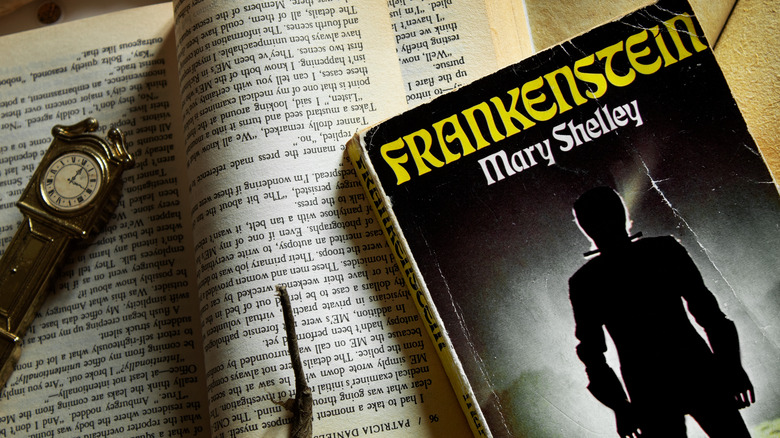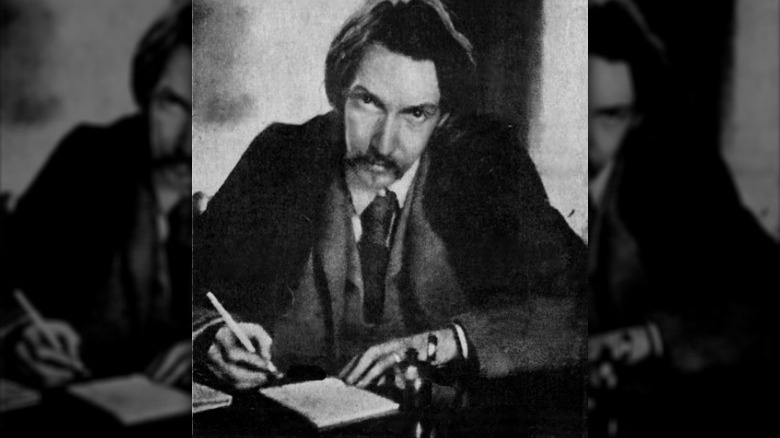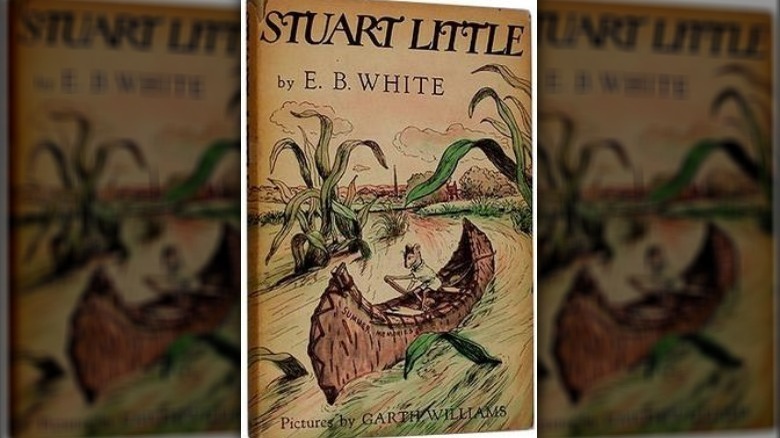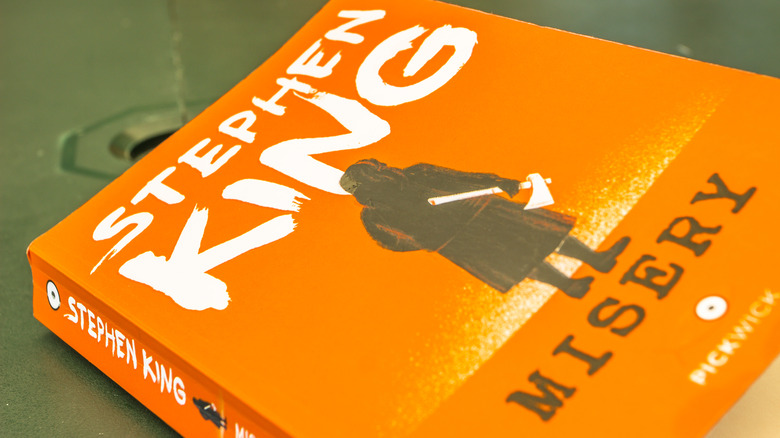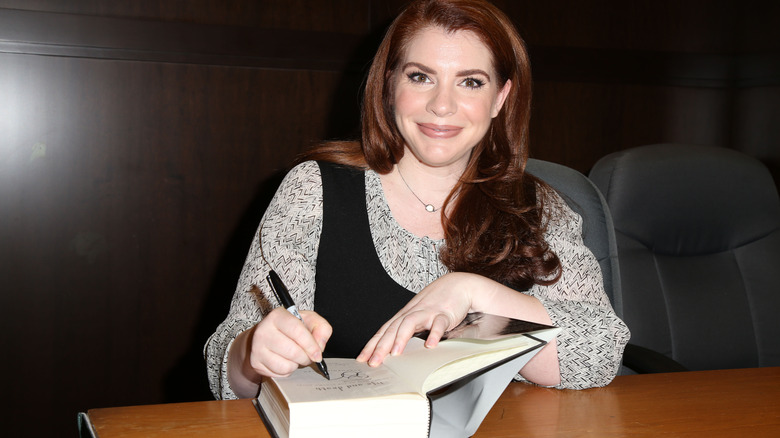These Famous Books Were Inspired By Dreams
We all dream — though some of us certainly have more interesting dreams than others. You've almost certainly had this happen to you: you wake up from a particularly fascinating dream, excited to tell it to someone or write it down, only for it to fade from your mind before you can.
A particularly tragic example of this experience occurred to the English poet Samuel Taylor Coleridge in 1797. According to his account (republished by Project Gutenberg), Coleridge recalls drawing the inspiration for his now-famous poem "Kubla Khan" from a dream. In fact, the way he tells it, the poem came to him in his dream fully-formed, line by line. Obviously, when Coleridge woke up, he began transcribing the lines of his dreamed-up poem, expecting that there'd be about 200 to 300 lines in all. But, in the middle of his writing, he was called from his desk by "a person on business from Porlock," who spoke to him for upwards of an hour. When Coleridge finally sat back down to write, he found that the rest of the poem had disappeared from his mind. Thus, the "Kubla Khan" that we're left with is just the first 54 lines of what could have been a much longer work.
It's a sad tale that forces you to wonder how many brilliant dreamed-up stories have slipped from the minds of skillful authors. Instead, let's take a look at some authors who remembered their dreams, and used them as inspiration to write world-famous novels.
Mary Shelley's 'Frankenstein' began as a half-awake nightmare
The story behind the creation of "Frankenstein" is fascinating. Per the Independent, "Frankenstein" was written by Mary Shelley — just 18 years old at the time — during an 1816 vacation in Switzerland with the poets Percy Bysshe Shelley (her soon-to-be husband), Lord Byron, and a physician named John Polidori. It was a pretty star-studded retreat, made even more interesting when Lord Byron challenged each guest to write their best horror story.
Shelley's novel "Frankenstein" was unquestionably the most influential work to come out of that competition. It also began as a nightmare. Years after her Swiss retreat, Shelley wrote a preface to the 1831 edition of "Frankenstein," republished by Project Gutenberg, where she lays out the inspiration for her novel. She describes listening to a conversation between Lord Byron and Percy Shelley, in which they discussed recent experiments — possibly legends — to reanimate dead creatures with electricity.
Disturbed at the thought, Shelley had a vision that night: "I saw the hideous phantasm of a man stretched out, and then, on the working of some powerful engine, show signs of life, and stir with an uneasy, half vital motion." Likewise, she saw the man who created this creature recoil in horror. From this vision, the story for "Frankenstein" emerged. That said, Shelley recalls being awake during this vision, though not fully lucid: "I did not sleep, nor could I be said to think." For the rest of this article, we'll stick to a more strict definition of "dream."
Robert Louis Stevenson's 'Dr. Jekyll and Mr. Hyde' was based on a fever dream
Interestingly, the next major example of a famous dream-inspired book is also a British science fiction/horror novel from the 19th century. We're referring to "The Strange Case of Dr. Jekyll and Mr. Hyde," written by Scottish author Robert Louis Stevenson in 1886.
The main plot of "Jekyll and Hyde" — where an upstanding English citizen has an evil, serum-induced alter-ego — was inspired by a dream. And not just any dream, but a "cocaine-induced nightmare," according to The Guardian. Stevenson was an ill man, likely suffering from tuberculosis, and cocaine was a standard medicinal treatment at the time. One night, Stevenson's wife, Fanny, chose to wake him during a particularly feverish nightmare. She later recalled, per Stevenson's 1912 biography, that, "In the small hours of one morning ... I was awakened by cries of horror from Louis. Thinking he had a nightmare, I awakened him. He said angrily: 'Why did you wake me? I was dreaming a fine bogey tale.'"
If Stevenson's response sounds a bit rude, you may be pleased to know that Fanny burned the first draft of his story, per the Guardian — though the exact reasons she did so are unclear. That rough draft took Stevenson just three days to write, and his final 30,000-word manuscript only took three more days to complete. That's a ridiculously fast pace — as anyone who has had to write a 1,000-word essay can attest. (The medicinal cocaine probably helped.)
E.B. White's 'Stuart Little' began as a dream about a 'mouse-child'
Thankfully, not all dream-inspired books have to be horror; pleasant dreams can be just as innovative as nightmares. That brings us to "Stuart Little." While modern audiences might best remember "Stuart Little" as a 1999 movie, the story began as a children's novel penned by E.B. White in 1945. (White is perhaps best remembered as the author of "Charlotte's Web.") Per the New Yorker, White recalls being inspired to write "Stuart Little" after he fell asleep on a train and "dreamed of a small character who had the features of a mouse, was nicely dressed, courageous, and questing."
That's a fairly simple starting point, but White had 18 nieces and nephews who were always begging for stories, so he figured that his dreamed-up mouse might make a good protagonist. He began writing about the "mouse-child" — "the only fictional figure ever to have honored and disturbed my sleep." Thus, Stuart was born.
Still, it took nearly two decades for White's mouse-child to see the light of day; White had his dream around 1926, but "Stuart Little" wasn't published until 1945. As the New Yorker explains, White chose to publish "Stuart Little" following encouragement from his wife, Katharine. Katharine White reviewed children's stories for the New Yorker and saw that her husband's work had potential. Evidently, she was right; "Stuart Little" was White's first novel for children, and it was a massive success.
Stephen King's 'Misery' was inspired by a dream on a flight
At 63 novels (and counting), Stephen King is one of the most prolific authors of the 20th and 21st centuries. So it should come as no surprise that some of King's story ideas come from unusual sources. For instance, the inspiration for King's 1987 psychological horror novel "Misery" came from a dream he had on an American Airlines flight to London.
King documents the event in his memoir "On Writing." He writes, "I fell asleep on the plane and had a dream about a popular writer ... who fell into the clutches of a psychotic fan living on a farm somewhere out in the back of the beyond." In his dream, that paranoid fan was so obsessed with the author that she even had a pet pig, Misery, named after the protagonist of the author's romance series. As any good author should, King immediately began scribbling his dream onto an American Airlines cocktail napkin, focusing on his description of the crazed fan: "She speaks earnestly but never quite makes eye contact. A big woman and solid all through; she is the absence of hiatus."
King further explored his dream in his London hotel (writing at a desk which, he was told, had once been Rudyard Kipling's). Over the months that followed, King continued to expand and adjust his story — but the core of 1987's "Misery" was exactly as King had seen it in his dream.
Stephenie Meyer's 'Twilight' started as a dream about a 'sparkly' vampire
Perhaps the most recent example of a famous dream-inspired book is the 2005 vampire-romance novel "Twilight," written by Stephenie Meyer. Speaking to Oprah (as reported in CNN), Meyer recalls her dream as "two people in kind of a little circular meadow with really bright sunlight, and one of them was a beautiful, sparkly boy and one was just a girl who was human and normal, and they were having this conversation." She continues, "The boy was a vampire, which is so bizarre that I'd be dreaming about vampires, and he was trying to explain to her how much he cared about her and yet at the same time how much he wanted to kill her."
Meyer's dream would later serve as Chapter 13 of "Twilight," with the rest of the story being built around that scene. But CNN reports that Meyer didn't initially plan to turn her dream into a novel. First, she wrote down her dream simply because she wanted to remember it. Then, she continued exploring her newfound fantasy world as a means to work through the stress she was feeling as a busy mother. "It was just me spending time with this fantasy world," Meyer recalls, "and then when it was finished it was like, 'This is long enough to be a book!'"
Following the success of the "Twilight" books and movies, Meyer now has an estimated net worth of $120 million. In other words: don't ignore your dreams!

